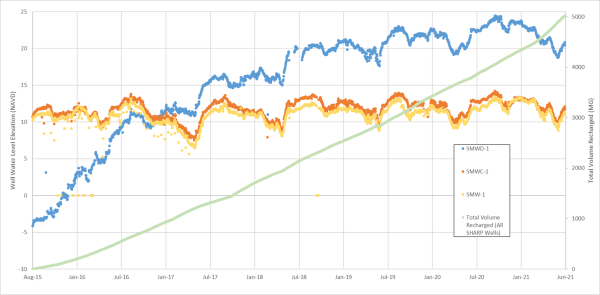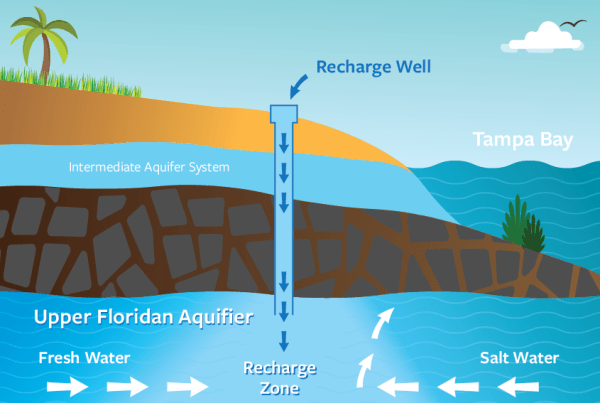Current project results and future focus
Water supply challenges
The Upper Floridan Aquifer is the principal source of water in most of north and central Florida. The amount of groundwater available in the aquifer is impacted by pumping for public and private water supplies, changes in weather cycles and precipitation patterns, and increases in sea level.
When fresh groundwater volumes decrease in the aquifer, saltwater migrates inland and decreases freshwater storage in the aquifer. In extreme cases, this can result in the abandonment of wells. Historical increases in groundwater withdrawals have resulted in significant saltwater intrusion in coastal portions of the aquifer, including in Hillsborough County.
Innovative solution to historical problem
In 2009, Hillsborough County Public Utilities started investigating the potential use of its high-level disinfection public access-quality reclaimed water to:
- Act as a barrier to saltwater intrusion
- Create a path to the restoration of local water levels
- Support a long-term and sustainable solution to water management challenges in the Hillsborough County Public Utilities service area.
In coordination with the Southwest Florida Water Management District and the Florida Department of Environmental Protection, Hillsborough County embarked on two reclaimed water in direct aquifer recharge pilot projects along the coastal county in a non-drinking water portion of the aquifer.
- The projects essentially pumps highly treated reclaimed water into the saltwater zone that separates the water under Tampa Bay from the freshwater in the aquifer
- The recharge water creates a fresh water barrier that not only helps to prevent saltwater intrusion into the freshwater portion of the aquifer but also helps impound fresh water several miles inland, improving the environment and water levels upstream of the recharge area.
- The wells pumping small amounts of reclaimed water into the recharge zone are near the coast and several miles away from any public supply wells that take fresh groundwater from the aquifer
- Groundwater naturally flow towards the Gulf of Mexico, which pushes the reclaimed water away from the areas where public supply withdrawal wells are located
- The County operates multiple monitoring and recharge wells to regularly track water levels and water quality in the aquifer
- Both projects are closely regulated by the Florida Department of Environmental Protection and the Southwest Florida Water Management District
The Systems
South Hillsborough Aquifer Recharge Project (SHARP)
- First reclaimed water aquifer recharge project in the region
- Began operation in 2015
- Located near Apollo Beach/Ruskin area, near U.S. 41
- Presently recharges up to 14 million gallons per day (MGD) annual average
- Presently, the planned system will include six recharge wells, three currently operational and three proposed
- The system is monitored on a daily, weekly, monthly, and annual basis to confirm compliance with groundwater standards
North Hillsborough Aquifer Recharge Project (NHARP)
- Began operation in 2021
- Located near Town ‘N’ Country area, north of Hillsborough Avenue
- Recharges up to 5 MGD
- Presently, the planned system will include three recharge wells
- The system is monitored on a daily, weekly, monthly, and annual basis to confirm compliance with groundwater standards
Results so far
While it is too soon to know the results from NHARP, data from SHARP has shown significant recovery of fresh groundwater storage levels, a halt in saltwater intrusion, and seasonal stabilization in the aquifer in the area of recharge. Water quality testing has shown no negative impacts where fresh water withdrawals occur.
- Over 750 million gallons per day (MGD) of groundwater is withdrawn from the Southern Water Use Caution Area (SWUCA) for use
- Volume of drinking water withdrawals within the SWUCA are approximately 150 MGD
- Presently the volume of reclaimed recharge is less than 12 MGD

Additionally, these programs have the potential to help support the Southwest Florida Water Management District’s goal to achieve minimum levels of saltwater intrusion in the SWUCA through reducing groundwater pumping from the aquifer by 50 MGD by 2025.
Safely impounding fresh water in the aquifer provides a net gain in water volume, which allows water resources to recover from past overpumping while maintaining permitted water withdrawals for communities.
Future focus
As part the County’s One Water integrated approach to water management, these projects support a goal of 100 percent reuse capacity. More importantly, the success of SHARP has provided a proof of concept by tackling the challenge of localized saltwater intrusion in the aquifer.
Hillsborough County plans to continue funding and operating these projects, increasing the number of recharge wells to expand the environmental benefits for the County’s fresh water resources and the proven protection they provide against saltwater intrusion.




